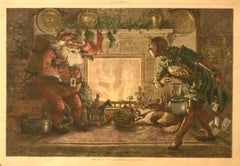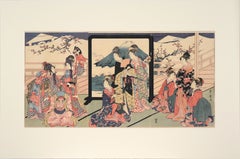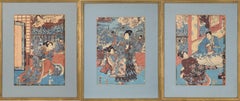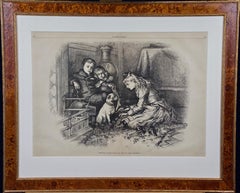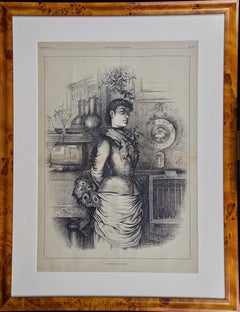Thomas Nast Prints and Multiples
to
1
Overall Width
to
Overall Height
to
1
1,158
902
822
802
1
1
1
1
1
1
1
1
Artist: Thomas Nast
Here We Are Again by Thomas Nast 1878 Harpers Weekly centerfold
By Thomas Nast
Located in Paonia, CO
Here we go again is an original hand colored wood engraving from a January 1878 Harpers Weekly. Here we see Thomas Nast's ever enduring interpretation of Santa Clause modeled from Clement Moore's Visit from Saint Nicholas. Drawing inspiration from his native German Saint Nicholas, Nast helped the American people believe in a Santa Clause who kindness and generosity brought with it elves, reindeer pulling sleds, Santas workshop, using chimneys...
Category
1870s Thomas Nast Prints and Multiples
Materials
Woodcut
Related Items
"Toy Horse Dance" Japanese Woodblock Triptych with Beauties and Mt Fuji
Located in Soquel, CA
"Toy Horse Dance" Japanese Woodblock Triptych with Beauties and Mt Fuji
Vibrant three-panel woodblock print by Utagawa Toyohiro (Japanese,...
Category
Early 20th Century Edo Thomas Nast Prints and Multiples
Materials
Ink, Rice Paper, Woodcut
Utagawa Toyohiro"Toy Horse Dance" Japanese Woodblock Triptych with Beauties and Mt Fuji, early 1900s
$1,360 Sale Price
20% Off
H 24 in W 36 in D 0.25 in
The Four Seasons: Spring Japanese Woodblock Triptych ink on Paper Tales of Genji
Located in Soquel, CA
The Four Seasons: Spring - Japanese Woodblock Triptych in Ink on Paper
Colorful kabuki scene by Utagawa Kuniteru (Japanese, active 1818-18...
Category
Early 19th Century Edo Thomas Nast Prints and Multiples
Materials
Paper, Ink, Woodcut
$1,480 Sale Price
20% Off
H 18.75 in W 44.25 in D 0.75 in
Elegant Amusements of Eastern Genji - Japanese Triptych Woodblock Print on Paper
By Utagawa Kunisada (Toyokuni III)
Located in Soquel, CA
Elegant Amusements of Eastern Genji - Japanese Triptych Woodblock Print on Paper
Dynamic woodblock print with several elegantly dressed figures by Utag...
Category
1850s Edo Thomas Nast Prints and Multiples
Materials
Paper, Ink, Woodcut
$1,240 Sale Price
20% Off
H 22.5 in W 32.5 in D 1 in
The Lonely House at Asajigahara.
Located in Middletown, NY
A scene from a series of ghost stories and spooky rural legends.
Tokyo: Matsuki Heikichi, 1896.
Woodcut in ink with embossing and hand-coloring in watercolor on handmade mulberry pa...
Category
Late 19th Century Edo Thomas Nast Prints and Multiples
Materials
Watercolor, Handmade Paper, Woodcut
Annual Events for Young Murasaki (July) - Tales of Genji - Japanese Woodblock
By Utagawa Kunisada (Toyokuni III)
Located in Soquel, CA
Annual Events for Young Murasaki (July) - Tales of Genji - Japanese Woodblock
Rightmost panel a triptych, depicting monthly events for Wakamurasaki (Young Murasaki). This is the month of July. There appears to be a lesson taking place, possibly for writing or poetry.
Artist: Toyokuni III/Kunisada (1786 - 1864)
Publisher: Ebisu-ya Shoshichist
Presented in a new blue mat.
Mat size: 19"H x 13"W
Paper size: 14.5"H x 10"W
Commentary on the triptych:
In the Edo period, Tanabata was designated as one of the five seasonal festivals, and became an annual event for the imperial court, aristocrats, and samurai families, and gradually came to be celebrated by the general public. Its origins are said to be a combination of the Kikoden festival, which originated from the Chinese legend of Altair and the Weaver Girl, and Japan's ancient Tanabata women's faith. Ink is ground with dew that has accumulated on potato leaves, poems and wishes are written on five colored strips of paper, which are then hung on bamboo branches to celebrate the two stars that meet once a year. Although the illustration is a Genji painting...
Category
1850s Realist Thomas Nast Prints and Multiples
Materials
Printer's Ink, Rice Paper, Woodcut
$682 Sale Price
30% Off
H 19 in W 13 in D 0.25 in
Kumasaka Chōhan to Ushiwakamaru - One of a Diptych Original Woodcut Print
By Utagawa Kunisada (Toyokuni III)
Located in Soquel, CA
Kumasaka Chōhan to Ushiwakamaru is a Japanese Ukiyo-e print created between 1848 and 1854 by artist Utagawa Kunisada (Japanese, 1786-1864). The print is a Diptych, and is part of the...
Category
1850s Realist Thomas Nast Prints and Multiples
Materials
Printer's Ink, Rice Paper, Woodcut
$880 Sale Price
20% Off
H 18.5 in W 13.68 in D 0.38 in
The Metro Station in Paris - Original Woodcut by S. Birga - 1994
Located in Roma, IT
The Metro Station in Paris is an original contemporary artwork realized by Sergio Birga (Florence, 1940) in 1994.
Original B/W xylograph on ivory paper. Pa...
Category
1990s Modern Thomas Nast Prints and Multiples
Materials
Woodcut
$298
H 5.91 in W 8.67 in D 0.08 in
Kabuki actor Nakamura Shikan II by Utagawa Kunisada Edo Japanese Woodblock Print
By Utagawa Kunisada (Toyokuni III)
Located in Soquel, CA
Kabuki actor Nakamura Shikan II by Utagawa Kunisada Japanese Woodblock Print
Wonderful portrait of Nakamura Shikan II, a prominent kabuki actor, in the role of Kisen Hoshi Toyokuni ...
Category
1820s Realist Thomas Nast Prints and Multiples
Materials
Printer's Ink, Rice Paper, Woodcut
$357 Sale Price
35% Off
H 21.75 in W 16.75 in D 1.25 in
Deutzia Flowers: The Wife of Kasamori - Original Woodblock Print
Located in Soquel, CA
Deutzia Flowers: The Wife of Kasamori - Original Woodblock Print
Deutzia Flowers: The Wife of Kasamori, from the Series "Beauties of the Floating World Associated with Flowers" by S...
Category
1760s Edo Thomas Nast Prints and Multiples
Materials
Woodcut, Ink, Rice Paper
$720 Sale Price
20% Off
H 18 in W 14 in D 0.5 in
Ichimura Uzaemon XIII - actor as Okaji of Gion, 1862 "The Six Poetry Immortals"
By Utagawa Kunisada (Toyokuni III)
Located in Soquel, CA
Ichimura Uzaemon XIII - actor as Okaji of Gion, 1862 "The Six Poetry Immortals"
A Japanese Ukiyo-e woodcut print created circa 1862 by artist Utagawa Kunisada (Japanese, 1786-1864). ...
Category
1850s Realist Thomas Nast Prints and Multiples
Materials
Printer's Ink, Rice Paper, Woodcut
$680 Sale Price
20% Off
H 21.75 in W 16.75 in D 1.25 in
"House Cleaning in Preparation for the New Year" - Japanese Woodblock on Paper
By Kitagawa Utamaro 1
Located in Soquel, CA
"House Cleaning in Preparation for the New Year" - Japanese Woodblock on Paper
House cleaning scene by Kitagawa Utamaro (Japanese, 1753-1806). This print was originally published around 1796-1799, with this example being a later reprint. The full scene is five sheets - there are two more sheets to the right that show more members of the house. However, it is these three sheets that contain the majority of the action - a maid sweeping at a mouse, a lady fainting, and a painting moved aside to allow for cleaning.
Presented in a new black mat.
Mat size: 24"H x 38"W
Paper size: 17.75"H x 33"W
Print Impression: 14.63"H x 29.5"W
Utamaro Kitagawa...
Category
18th Century Edo Thomas Nast Prints and Multiples
Materials
Rice Paper, Woodcut
$920 Sale Price
20% Off
H 24 in W 38 in D 0.25 in
Men in Room - Original Etching - Early 19th Century
Located in Roma, IT
Image dimensions: 20 x 15 cm.
Men in Room is an original etching on paper, realized by an Anonymous artist in the Early 19th Century, following the so-called "Historic Romanticism"....
Category
Early 19th Century Thomas Nast Prints and Multiples
Materials
Woodcut
$238
H 9.85 in W 13.78 in D 0.08 in
Previously Available Items
"Christmas Fancies", Thomas Nast Harper's Weekly Engraving, 19th Century
By Thomas Nast
Located in Alamo, CA
"Christmas Fancies - Don't You Wish You Wore Stockings?" is a double page woodcut engraving created by Thomas Nast. It was published in Harper's Weekly's Christmas issue on December 24, 1881. It depicts three children and their dog sitting by a fire in their home, presumably on Christmas Eve. They are about to hang their Christmas stockings in preparation for Santa Claus's visit. The oldest girl jokingly asks their dog if it wishes it wore stocking so that it could be the recipient of Christmas presents.
The engraving is presented in an attractive burl wood frame with gold trim along its inner and outer edges, with a white mat. There are small tears along the double page vertical fold at the binding cord attachments, as well as spotting of the mat, but it does not appear to affect the print.
Harper’s Weekly, published in New York, was an extremely popular publication in the nineteenth and early twentieth centuries. In weekly issues Harper’s reported the news, entertained with literature, poetry and art, as well as educating its readers about world affairs and new inventions. It's woodcut engraved illustrations and literature added to its popularity, employing major artists and authors of the time, including Winslow Homer, Charles Dickens, William Makepeace Thackeray and Thomas Nast. Nast is considered the father of American political cartoons...
Category
Mid-19th Century Other Art Style Thomas Nast Prints and Multiples
Materials
Engraving, Woodcut
H 23.38 in W 28.38 in D 0.88 in
"Christmas Flirtation", Thomas Nast Harper's Weekly Engraving, 19th Century
By Thomas Nast
Located in Alamo, CA
"Christmas Flirtation" is a double page woodcut engraving by Thomas Nast which appeared in the December 23, 1882 Christmas supplement of Harper's Weekly. It depicts a woman standing under mistletoe and next to a portrait of Santa. It is one of Thomas Nast's most famous Christmas engravings.
The engraving is presented in a beautiful burl wood frame with a cream colored mat. There is a horizontal fold where it was attached to the binding and one faint spot in the upper right margin. The print is otherwise in very good condition.
Harper’s Weekly, published in New York, was an extremely popular publication in the nineteenth and early twentieth centuries. In weekly issues Harper’s reported the news, entertained with literature, poetry and art, as well as educating its readers about world affairs and new inventions. It's woodcut engraved illustrations and literature added to its popularity, employing major artists and authors of the time, including Winslow Homer, Charles Dickens, William Makepeace Thackeray and Thomas Nast. Nast is considered the father of American political cartoons...
Category
Mid-19th Century Other Art Style Thomas Nast Prints and Multiples
Materials
Engraving, Woodcut
H 28.75 in W 22.75 in D 1 in
Christmas 1873, "The Same Old Story", Thomas Nast Harper's Weekly Engraving
By Thomas Nast
Located in Alamo, CA
Thomas Nast's Christmas illustration “The Same Old Story Over Again” was published in Harper’s Weekly on January 4, 1873. The illustration shows two sleeping children, likely his own children, Thomas Jr. and Edith, dreaming of the childhood stories and nursery rhymes that they had been told, including Puss in Boots, Jack and Jill and Little Red Riding Hood among many other stories. In the upper left hand corner of the illustration, the Mother Goose nursery rhyme “Hey Diddle Diddle” is depicted showing the cow jumping over the moon...
Category
Mid-19th Century Thomas Nast Prints and Multiples
Materials
Engraving, Woodcut
H 24.75 in W 30.38 in D 1 in
A Pair of Civil War Christmas Thomas Nast Harper's Weekly Woodcut Engravings
By Thomas Nast
Located in Alamo, CA
This pair of original 1863 Thomas Nast double page woodcut engravings entitled "Christmas Eve" and "Christmas 1863" are two of Nast's most famous Christmas illustrations.
"Christmas Eve" is the 1st of a 25 year tradition of his Christmas themed Harper's Weekly holiday illustrations. It depicts a touching and dramatic scene of a husband and wife separated on Christmas Eve 1862 by the Civil War. It appeared in the January 3, 1863 edition of Harper's Weekly. The left image shows a woman on her knees looking out a window at a snowy scene. Her children are in bed asleep in the background and a picture of her husband hangs crooked on the wall. She is in earnest prayer for a safe return for her husband who is a Civil War union soldier. The image on the right shows her husband, obviously lonely sitting by a fire on a cold Christmas Eve, holding his rifle and looking longingly at an album of photographs of his family.
A vignette in the upper left corner shows Santa Claus about to go down a chimney to deliver presents. His sleigh and reindeer await on the roof. The vignette in the upper right corner shows Santa Claus in his sleigh, pulled by his reindeer, waiving to troops in their camp and distributing presents. These were the first images to show Santa Claus as we now appreciate him. Thomas Nast, through his Harper's Weekly illustrations, beginning in this issue, is responsible for creating our modern image of Santa Claus. See the New Yorker magazine article of 12/8/1997 entitled "The Man Who Invented Santa Claus" and the Smithsonian article "A Civil War Cartoonist Created the Modern Image of Santa Claus as Union Propaganda", December 19, 2018.
The vignette in the lower left corner depicts troops marching through the snow, presumably heading to battle. The scene in the lower right corner depicts a Union sailing warship tossed in a storm with a canon on land pointed towards it, symbolizing the challenges endured by the nation . A small vignette in the lower center shows graves and head stones of soldiers lost in the war. Thomas Nast's signature is present in plate in the lower right corner.
The second of these Nast double page Christmas engravings, "Christmas 1863", was published in the December 26, 1863 edition of Harper’s Weekly. It was is meant to be a follow-up to Thomas Nast's 1st Christmas themed illustration "Christmas Eve" 1862, described above. The "Christmas Eve" engraving depicts a family separated at Christmas by the Civil War. The same family is depicted in “Christmas 1863,” the couple is now happily reunited as the husband has survived a year of war and returns home on furlough. The Center panel is a touching picture of the Civil War soldier coming home from the war on Christmas Morning. He receives a warm greeting from his wife and his son, although his daughter mysteriously does not seem happy. The panel to the left is one of the first popular images of Santa Claus, which was invented by Nast. Santa is shown coming out of the chimney on Christmas Eve with his large sack of toys on his back, and he is looking at the sleeping children. in the right panel, children are shown with their Christmas stockings and gifts on Christmas morning, with adults observing their joy. The bottom center inset shows the family around the Christmas Dinner table. The small vignette in the lower left, labeled "Eve" may be a religious scene and the vignette in the lower right corner labelled "Morning" appears to show families greeting each other at church on Christmas morning.
These important engravings are held by many museums and institutions, including The Library of Congress, The Metropolitan Museum of Art, The Smithsonian Institute, The Fine Arts Museums of San Francisco.
These engravings are presented in identical bronze colored wood frames and a white mats. These illustrations may be purchased separately on 1stDibs, see "Christmas Eve", Reference #: LU117325453581" and "Christmas 1863", Reference #: LU117325453591. They would make a striking and important grouping. The pair is listed at a discount here compared to the price of purchasing each engraving separately.
Harper’s Weekly, published in New York, was an extremely popular publication in the nineteenth and early twentieth centuries. In weekly issues Harper’s reported the news, entertained with literature, poetry and art, as well as educating its readers about world affairs and new inventions. It's woodcut engraved illustrations and literature added to its popularity, employing major artists and authors of the time, including Winslow Homer, Charles Dickens, William Makepeace Thackeray and Thomas Nast. Nast is considered the father of American political cartoons...
Category
Mid-19th Century Other Art Style Thomas Nast Prints and Multiples
Materials
Engraving, Woodcut
H 23.38 in W 28.38 in D 1 in
"Christmas 1863", Thomas Nast's Civil War Harper's Weekly Woodcut Engraving
By Thomas Nast
Located in Alamo, CA
This double page woodcut engraving, "Christmas 1863", is meant to be a follow-up to Thomas Nast's 1st Christmas themed illustration "Christmas Eve" 1862, published in Harper's Weekly in the January 3, 1883 issue. The "Christmas Eve" engraving depicts a family separated at Christmas by the Civil War. At home the wife prays for her husband's safe return, while he sits by a fire in the field looking longingly at a small album of photos of his family. The same family is depicted the following Christmas in this illustration from the December 26, 1863 edition of Harper’s Weekly. In “Christmas 1863,” the couple is happily reunited as the husband returns home on furlough. The Center panel is a touching picture of the Civil War soldier coming home from the war on Christmas Morning. He receives a warm greeting from his wife and his son, although his daughter mysteriously does not seem happy. The panel image to the left is one of the first popular images of Santa Claus, which was invented by Nast. Santa is shown coming out of the chimney on Christmas Eve with his large sack of toys on his back, and he is looking at the sleeping children. in the right panel, children are shown with their Christmas stockings and gifts on Christmas Morning with adults observing their joy. The bottom center inset shows the family around the Christmas Dinner table. The small vignette in the lower left, labeled "Eve" may be a religious scene and the vignette in the lower right corner labelled "Morning" appears to show families greeting each other at church on Christmas morning.
This important engraving is held by many museums and institutions, including The Library of Congress, The Metropolitan Museum of Art, The Smithsonian Institute and The Fine Arts Museums of San Francisco.
The engraving is presented in a bronze colored wood frame and a white mat. There are small holes along the vertical double page center fold, related to the cords that held the Harper's Weekly 1863 annual together. There is spotting in the print margin and on the mat, but only one tiny spot is visible in the printed area.
The frame and mat are identical to the 1st of Thomas Nast's Harper's Weekly Civil War Christmas engravings, mentioned above and listed on 1stDibs, entitled "Christmas Eve", published January 8, 1863, Reference #LU117325453581. They would make a striking and important grouping. The pair is listed at a discount, see Reference #LU117325453681.
Harper’s Weekly, published in New York, was an extremely popular publication in the nineteenth and early twentieth centuries. In weekly issues Harper’s reported the news, entertained with literature, poetry and art, as well as educating its readers about world affairs and new inventions. It's woodcut engraved illustrations and literature added to its popularity, employing major artists and authors of the time, including Winslow Homer, Charles Dickens, William Makepeace Thackeray and Thomas Nast. Nast is considered the father of American political cartoons...
Category
Mid-19th Century Other Art Style Thomas Nast Prints and Multiples
Materials
Engraving, Woodcut
Ciivil War "Christmas Eve" 1862, Thomas Nast Harper's Weekly Woodcut Engraving
By Thomas Nast
Located in Alamo, CA
This original 1863 Thomas Nast double page woodcut engraving entitled "Christmas Eve" depicts a touching and dramatic scene of a husband and wife separated on Christmas Eve 1862 by the Civil War. It appeared in the January 3, 1863 edition of Harper's Weekly. The left image shows a woman on her knees looking out a window at a snowy scene. Her children are in bed asleep in the background and a picture of her husband hangs crooked on the wall. She is in earnest prayer for a safe return for her husband who is a Civil War Union soldier. The image on the right shows her obviously lonely husband sitting by a fire on a cold Christmas Eve, holding his rifle and looking longingly at an album of photographs of his family.
A vignette in the upper left corner shows Santa Claus about to go down a chimney to deliver presents. His sleigh and reindeer await on the roof. The vignette in the upper right corner shows Santa Claus in his sleigh, pulled by his reindeer, waiving to troops in their camp. These were the first images to show Santa Claus looking and acting as we now appreciate him. Thomas Nast, through his Harper's Weekly illustrations, beginning in this issue, is responsible for creating our modern image of Santa Claus. See the New Yorker magazine article of 12/8/1997 entitled "The Man Who Invented Santa Claus" and the Smithsonian article "A Civil War Cartoonist Created the Modern Image of Santa Claus as Union Propaganda", December 19, 2018.
The vignette in the lower left corner depicts troops marching through the snow, presumably heading to battle. The scene in the lower right corner shows a Union sailing warship tossed in a storm with a canon on land pointed towards it, symbolizing the challenges endured by the nation. A small vignette in the lower center shows graves and head stones of soldiers lost in the war. Thomas Nast's signature is present in plate in the lower right corner.
This important engraving is held by many museums and institutions, including The Library of Congress, The Metropolitan Museum of Art, The Smithsonian Institute and The Fine Arts Museums of San Francisco.
The engraving is presented in a bronze colored wood frame and a white mat. There are five small holes along the double page vertical fold related to the cords that attached pages to the Harper's Weekly annual book that contained all of the 1863 issues. There is spotting of the mat and to a lesser extent the print margins. It is otherwise in very good condition.
The frame and mat are identical to another of Thomas Nast's Harper's Weekly Civil War Christmas engravings listed on 1stDibs entitled "Christmas 1863", published December 26, 1863, Reference #LU117325453591. it shows the same family at Christmas a year later The husband has survived another year of the Civil War and is home to celebrate Christmas with his wife and children. They would make a striking and important grouping. The pair is listed at a discount, see Reference #LU117325453681.
Harper’s Weekly, published in New York, was an extremely popular publication in the nineteenth and early twentieth centuries. In weekly issues Harper’s reported the news, entertained with literature, poetry and art, as well as educating its readers about world affairs and new inventions. It's woodcut engraved illustrations and literature added to its popularity, employing major artists and authors of the time, including Winslow Homer, Charles Dickens, William Makepeace Thackeray and Thomas Nast. Nast is considered the father of American political cartoons...
Category
Mid-19th Century Other Art Style Thomas Nast Prints and Multiples
Materials
Engraving, Woodcut
H 23.38 in W 28.38 in D 1 in
He Wants a Change Too, from "Harper's Weekly"
By Thomas Nast
Located in Paonia, CO
Thomas Nast ( 1846 - 1902)
Title: He Wants a Change Too
original wood engraving (double sheet )
Harpers Weekly 1876
paper size 22.00 x 15.50
condition...
Category
1870s Thomas Nast Prints and Multiples
Materials
Woodcut
Thomas Nast prints and multiples for sale on 1stDibs.
Find a wide variety of authentic Thomas Nast prints and multiples available for sale on 1stDibs. You can also browse by medium to find art by Thomas Nast in woodcut print and more. Not every interior allows for large Thomas Nast prints and multiples, so small editions measuring 27 inches across are available. Customers who are interested in this artist might also find the work of Charles Frederick William Mielatz, Fritz Eichenberg., and Antonio Mangano. Thomas Nast prints and multiples prices can differ depending upon medium, time period and other attributes. On 1stDibs, the price for these items starts at $550 and tops out at $550, while the average work can sell for $550.
